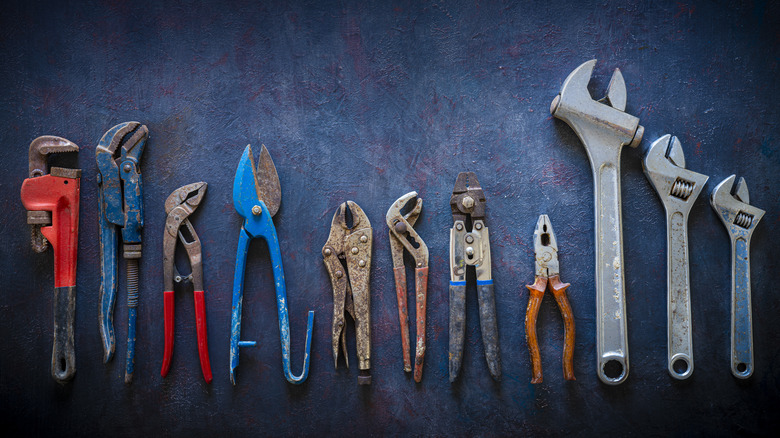
Mediterranean/Getty Images
Rusty tools can be unsightly, inefficient, and prone to breakage. Most tools have components that are made of steel and it’s a plain and simple fact that the scourge of corrosion will eventually claim any steel that isn’t properly cared for, as water and oxygen molecules oxidize the iron in them to flaky, red rust. This might be easy to ignore at first, but it can cause all kinds of problems as the rust spreads. Tools that should be sharp like blades and chisels will struggle to hold their edge, tools that have hinges like pliers and shears will cease to open and close easily, and even simple tools like a screwdriver can chip and break as the rust eats away at the integrity of the steel.
The best practice is to prevent this from happening by keeping your tools properly lubricated with a sealing agent and by storing them in a dry place where they will be safe from moisture. But that doesn’t mean you need to throw out old tools that have already started to rust. You can still save them so long as there is enough good steel underneath for the tool to function properly.
Rust can be stubborn and difficult to remove, however. A sponge with soap and water probably isn’t going to cut it. So how do you get rust off steel? Here are five methods for removing rust so you can restore your old tools to their former glory.
WD-40 and sandpaper
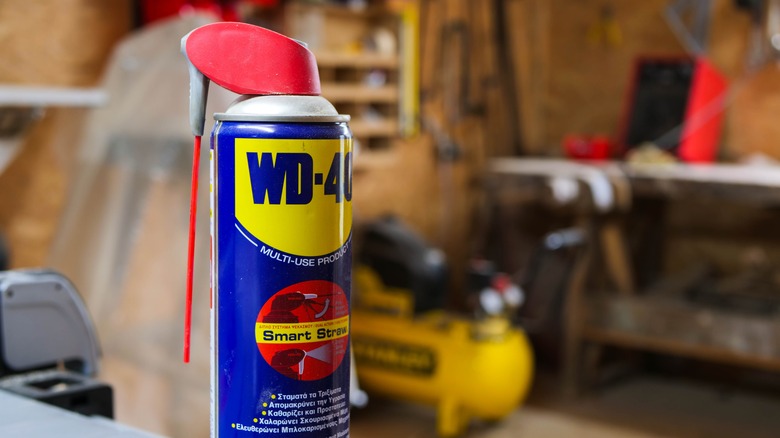
Benedek Alpar/Shutterstock
One of the easiest methods for removing rust from old tools is to use good ol’ WD-40 on it. Just about everyone has used this miracle spray lubricant to fix a squeaky hinge or loosen up a stubborn fastener, but you might not know that it’s great for removing rust too. This is one of the many reasons why so many mechanics consider WD-40 to be a garage essential.
WD-40 was originally developed by the aerospace industry for use as an anti-corrosive to prevent rust on spacecraft. The product is great for removing rust from metals like iron, chrome, and stainless steel. Best of all, it does so without causing any further damage to the metal or the paint. Start by spraying a liberal coat of the agent onto the rust-affected area of the tool and then leave it to soak for at least 10 minutes. This will allow the lubricant to soak into the rust and loosen its bonds to the metal. Once this is done, you’ll need to use something abrasive to scrape off the rust. You can try a shop towel first if you want to try and preserve the tool’s finish, but sandpaper is better for scraping away the more stubborn patches.
Using WD-40 has the added benefit of lubricating your tools and sealing them from further corrosion. The company also sells a Specialist Fast Release Penetrant Spray which is a bit stronger than the standard formula.
White vinegar and salt
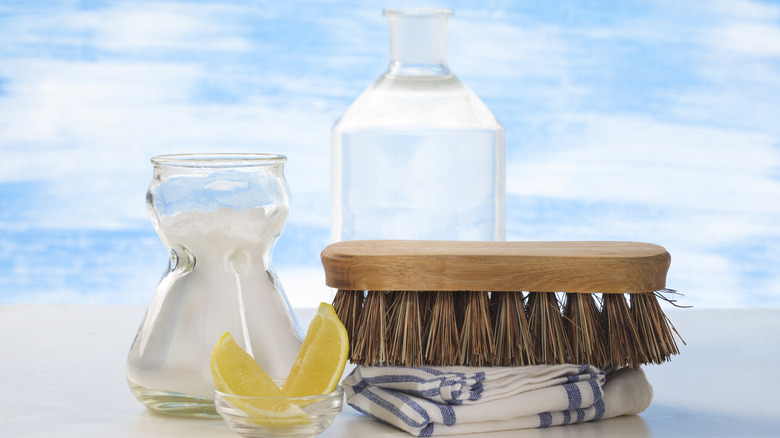
JPC-PROD/Shutterstock
Maybe you don’t have a can of WD-40 lying around, or you need an option for removing rust that doesn’t involve coating a specific tool in lubricant. Another simple method is to soak it in a bath of white vinegar. This common household item is one of the few things that matches WD-40 in its versatility. White vinegar can clean countertops, kill mold, serve as a fabric softener, make a good salad dressing, and help to remove rust. This is because white vinegar is extremely acidic. Other acids like the citric acid found in lemon juice work too, but nothing matches white vinegar in terms of cheapness and availability.
Cleaning rust off with vinegar takes a bit longer, but it’s still very effective. To do this, you need to find a glass or plastic container large enough that you can lay down your tool inside of it and then pour in enough vinegar so that the rusty parts of the tool are completely submerged. Depending on the level of corrosion, you may need to let the tool sit in the bath anywhere from a few minutes if your tool has light spotting to 24 hours if you need to remove more significant rust damage.
Once this is done soaking, some people like to use a towel to rub sea salt into the damaged area, allowing the coarse grains to scour any remaining rust from the tool. This should be thoroughly washed off afterward, however, as residual salt can cause rust to return faster.
Soak tools in oxalic acid
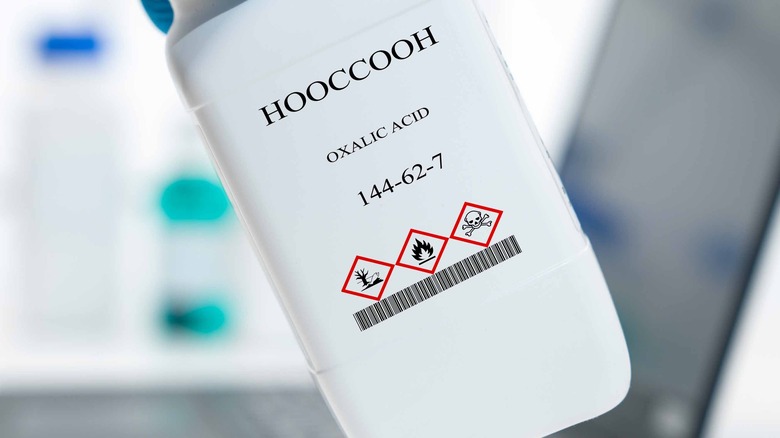
luchschenF/Shutterstock
There might be some cases where WD-40 and vinegar just don’t cut it. In these instances, you might need to turn to a more concentrated solution. Oxalic acid is an organic compound that is derived from leafy greens, along with certain fruits, nuts, and seeds. It’s significantly more acidic than vinegar and is often used by beekeepers for stripping wax, as an acid wash for clothing, and as an industrial rust remover. In fact, one common commercial use is stripping scale from car radiators.
You might have a hard time finding oxalic acid at your local hardware store, but it can be purchased quite cheaply online. Be careful when handling it, though. The same extremely corrosive properties of oxalic acid that make it so efficient at stripping rust also make it hazardous to handle. According to the New Jersey Department of Health, oxalic acid «can severely irritate and burn the skin and eyes with possible eye damage» and inhaling it «can irritate the nose, throat and lungs causing coughing, wheezing, and/or shortness of breath.» Prolonged exposure can lead to numerous other negative health effects as well. It’s also flammable.
Oxalic acid should only be used in a well-ventilated area and it should only be handled while wearing impenetrable gloves, protective clothing, eye protection, and a respirator. For these reasons, it is recommended that you exhaust all other options before resorting to using oxalic acid.
Scrape off rust with a wire brush
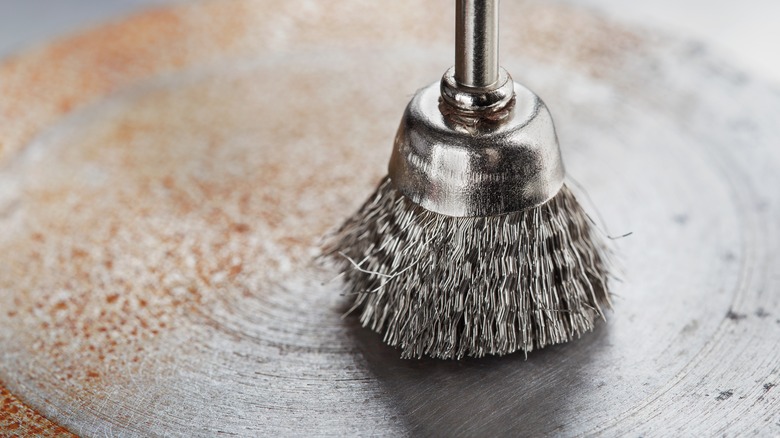
evkaz/Shutterstock
Setting aside chemical treatments for a moment, you might also consider taking some time to explore a few of the more mechanical methods of removing rust. Sandpaper, salt, and baking soda are good jumping-off points, but some projects require something a little more abrasive. In these situations, a good rotary wire brush is going to be your best friend.
There are several different kinds of power tools that make use of wire brushes. You could always use a burnisher if you have one, but there are wire brush attachments that are designed to fit power drills and smaller, Dremel-like, rotary tools as well. These kits are relatively inexpensive and can easily be found online or at your local hardware store. You simply lock them into the chuck of your drill and let the tool do all of the work. These kinds of brushes might not cover wider surface areas quite as quickly as a burnisher, but they are particularly handy for getting into the narrow grooves of wrenches, vice grips, and other tools that have parts that would be difficult to reach using a flat surface. Using a wire brush on a tool is particularly effective after you have coated it in WD-40 or soaked it in vinegar.
Take your tools to a sandblaster
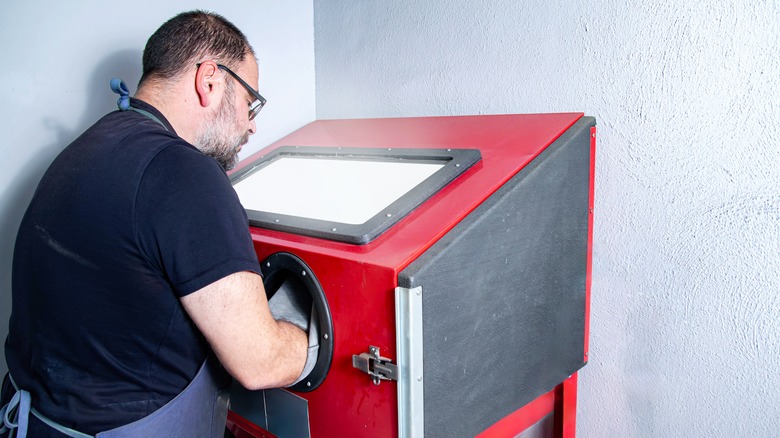
Boscaeta/Shutterstock
For those who’ve never used one, a sandblaster is an apparatus that uses an air compressor to shoot sand or other abrasive particles such as aluminum oxide out of a high-pressure nozzle. This is traditionally done inside a steel cabinet with a glass window that contains the sand and protects the wearer, though some people may simply opt to perform the task outside while wearing hand and eye protection and being careful to aim the nozzle away from themselves. You certainly don’t want to use an uncovered sandblaster in your garage as it would send sand and bits of rust all over the place. This is part of the reason why not very many people have a sandblaster in their home. They have limited functionality once your tools are free of rust and the cabinets can be quite bulky.
That said, sandblasters are one of the most effective methods of removing rust and there are businesses that allow you to rent one. You can either bring your tools into a shop that will charge for the use of its sandblaster or you can rent an abrasive blaster from a hardware store like Home Depot or Lowes to take home and use. This method probably isn’t worth it to clean up one or two tools, but it might be worthwhile if you find yourself with a large collection of rusty tools and you’d like to get them all clean and in working order in an afternoon.